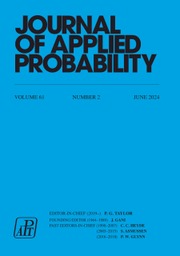No CrossRef data available.
Article contents
Ergodic properties of the Hawkes process with a general excitation kernel
Published online by Cambridge University Press: 30 June 2025
Abstract
The Hawkes process is a popular candidate for researchers to model phenomena that exhibit a self-exciting nature. The classical Hawkes process assumes the excitation kernel takes an exponential form, thus suggesting that the peak excitation effect of an event is immediate and the excitation effect decays towards 0 exponentially. While the assumption of an exponential kernel makes it convenient for studying the asymptotic properties of the Hawkes process, it can be restrictive and unrealistic for modelling purposes. A variation on the classical Hawkes process is proposed where the exponential assumption on the kernel is replaced by integrability and smoothness type conditions. However, it is substantially more difficult to conduct asymptotic analysis under this setup since the intensity process is non-Markovian when the excitation kernel is non-exponential, rendering techniques for studying the asymptotics of Markov processes inappropriate. By considering the Hawkes process with a general excitation kernel as a stationary Poisson cluster process, the intensity process is shown to be ergodic. Furthermore, a parametric setup is considered, under which, by utilising the recently established ergodic property of the intensity process, consistency of the maximum likelihood estimator is demonstrated.
Keywords
MSC classification
Information
- Type
- Original Article
- Information
- Copyright
- © The Author(s), 2025. Published by Cambridge University Press on behalf of Applied Probability Trust


